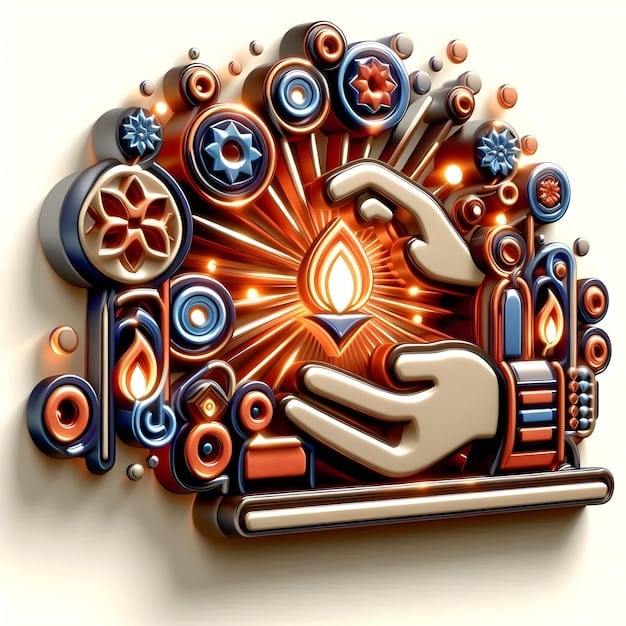AI-Driven Content Creation: Produce 5 Weekly Blog Posts Without Extra Staff

AI-Driven Content Creation allows businesses to efficiently generate high-quality blog posts, streamlining content marketing efforts and maximizing output by producing 5 weekly posts without the need for additional staff.
In today’s fast-paced digital landscape, content is king, but consistently creating high-quality blog posts can be a major challenge. AI-Driven Content Creation: Generate 5 High-Quality Blog Posts Per Week Without Hiring Additional Staff is now possible, transforming how businesses approach content marketing and offering a practical solution for boosting productivity and maintaining a strong online presence.
Revolutionizing Content Strategy with AI
Artificial intelligence is revolutionizing various aspects of business, and content creation is no exception. Understanding how AI can streamline the content creation process is essential for businesses looking to stay competitive.
The Evolution of Content Creation
Content creation has evolved significantly over the years. Traditional methods often involve extensive research, manual writing, and multiple rounds of editing. AI offers a faster, more efficient alternative.
Understanding AI’s Role
AI’s role in content creation extends beyond simple text generation. AI tools can assist with topic research, keyword analysis, content optimization, and even creating different content formats.
- Topic Generation: AI algorithms can identify trending topics and generate relevant content ideas.
- Keyword Optimization: AI tools can optimize content for search engines by identifying and incorporating relevant keywords.
- Content Refinement: AI can also assist in refining the language and tone of the content to suit the target audience.
AI is not meant to replace human creativity but to enhance it. By automating certain tasks, AI allows content creators to focus on strategy, creativity, and ensuring the content aligns with their brand’s voice.
Selecting the Right AI Tools for Content Creation
Choosing the right AI tools can significantly impact the quality and efficiency of your content creation process. With numerous options available, understanding which tools align with your specific needs is essential.

Key Features to Consider
When evaluating AI content creation tools, consider factors such as the tool’s ability to generate high-quality content, ease of use, customization options, and integration capabilities.
Popular AI Content Creation Tools
Several AI tools have gained popularity for their effectiveness in content creation. These include:
- GPT-3: Known for its advanced natural language processing capabilities, GPT-3 can generate a wide range of content, from blog posts to marketing copy.
- Jasper: Jasper is designed specifically for marketing and sales content, offering features like headline generation and content optimization.
- Rytr: Rytr is an AI writing assistant that helps users generate high-quality content quickly and easily.
The cost of AI tools varies depending on the features and usage. Consider your budget and content needs when making a decision.
Properly leveraging AI tools requires some level of training and experimentation. Start with a free trial or demo to see how the tool works and whether it aligns with your workflow.
Crafting a Content Strategy for AI-Driven Creation
While AI tools can automate much of the content creation process, a solid content strategy is essential for ensuring the generated content aligns with your business goals and meets the needs of your target audience.
Defining Content Objectives
Before diving into AI-driven content creation, define your content objectives. What do you want to achieve with your blog posts? Are you looking to increase website traffic, generate leads, or establish thought leadership?
Target Audience Analysis
Conduct a thorough analysis of your target audience to understand their interests, needs, and pain points. This information will help you tailor your content to resonate with them.
- Demographics: Consider factors like age, gender, location, and income level.
- Psychographics: Understand your audience’s values, interests, and lifestyle.
- Content Preferences: Determine what types of content your audience prefers, such as blog posts, videos, or infographics.
Develop a content calendar that outlines the topics you plan to cover, the format of each piece of content, and the publication schedule. A well-defined calendar helps maintain consistency.
A successful content strategy involves continuous monitoring and analysis. Track key metrics such as website traffic, engagement rates, and conversion rates to gauge the effectiveness of your content and make data-driven decisions.
Optimizing AI-Generated Content for SEO
Creating high-quality content is only half the battle. Optimizing that content for search engines is crucial for driving organic traffic to your website. AI tools can assist with SEO optimization by identifying relevant keywords, optimizing meta descriptions, and improving overall content structure.
Keyword Research
Keyword research is the foundation of any SEO strategy. AI tools can help you identify high-value keywords that are relevant to your target audience and have a good chance of ranking in search results.
On-Page Optimization
On-page optimization involves optimizing various elements of your content to improve its visibility in search results. AI tools can assist with:
- Title Tags: Crafting compelling title tags that include relevant keywords.
- Meta Descriptions: Writing concise and engaging meta descriptions that entice users to click on your content.
- Header Tags: Using header tags (H1, H2, H3) to structure your content and highlight important keywords.

Link building is an essential aspect of SEO. AI tools can help you identify link building opportunities by analyzing your content and suggesting relevant websites to reach out to.
SEO optimization is an ongoing process. Continuously monitor your website’s performance in search results and make adjustments to your content and strategy as needed.
Maintaining Quality and Authenticity
While AI tools can greatly speed up the content creation process, it’s important to ensure that the generated content maintains a high level of quality and authenticity. Over-reliance on AI can lead to generic, unoriginal content that fails to resonate with your audience.
The Human Touch
AI-generated content should be viewed as a starting point, not the final product. Always review and edit the content to ensure it aligns with your brand’s voice and meets your quality standards.
Originality Check
Before publishing any AI-generated content, run it through a plagiarism checker to ensure it’s original. Plagiarism can damage your website’s reputation and negatively impact its search engine rankings.
Ensuring Accuracy
Verify the accuracy of the information presented in the AI-generated content. AI tools can sometimes produce inaccurate or misleading information, so it’s important to double-check all facts and figures.
Encourage audience interaction by asking questions, soliciting feedback, and responding to comments. This helps build a sense of community and shows that you value your audience’s opinions.
Be transparent about your use of AI in content creation. Acknowledge that AI tools were used to generate the content and explain how you ensured its quality and accuracy.
Scaling Your Content Production
One of the primary benefits of AI-driven content creation is its ability to scale your content production without adding additional staff. By automating many of the time-consuming tasks associated with content creation, AI allows you to produce more content in less time.
Batch Content Creation
Use AI tools to generate multiple blog posts at once. This can be particularly useful for covering related topics or creating a series of posts on a specific theme.
Repurposing Content
Repurpose existing content into different formats using AI tools. For example, you can turn a blog post into a video script, an infographic, or a social media update.
- Video Scripts: Convert blog posts into engaging video scripts with AI.
- Infographics: Summarize key points from your content into visually appealing infographics.
- Social Media Updates: Generate concise and engaging social media updates from your blog posts.
Collaborate with other businesses or influencers in your industry to create content. AI tools can assist with brainstorming ideas, outlining content, and even writing co-authored posts.
Continuously evaluate your content production process and look for ways to improve efficiency. Experiment with different AI tools, strategies, and workflows to find what works best for your business.
| Key Point | Brief Description |
|---|---|
| 🤖 AI Tools Selection | Choosing the right AI tools is crucial for efficient content creation. |
| 🎯 Content Strategy | A solid content strategy ensures AI-generated content aligns with business goals. |
| 📈 SEO Optimization | Optimizing AI content for SEO boosts organic traffic significantly. |
| ✍️ Quality Control | Maintaining quality and authenticity requires a human touch. |
Frequently Asked Questions
▼
No, AI tools enhance human creativity rather than replacing it. They automate tasks, but human oversight is essential for quality and brand alignment.
▼
Consider features, ease of use, customization options, and integration capabilities. Start with trials to see what aligns best with your workflow and content objectives.
▼
Not necessarily. It’s crucial to run content through a plagiarism checker and add human edits to ensure originality and avoid copyright issues.
▼
Perform keyword research, optimize title tags and meta descriptions, and structure content with header tags to enhance its visibility in search results effectively.
▼
AI streamlines content creation, enabling higher output, faster turnaround, and greater efficiency. It can also reduce costs by automating routine tasks.
Conclusion
AI-Driven Content Creation presents a transformative opportunity for businesses seeking to amplify their content output without incurring additional staffing costs. By strategically integrating AI tools, businesses can generate five high-quality blog posts per week, optimize content for SEO, and maintain quality and authenticity with a human touch.





